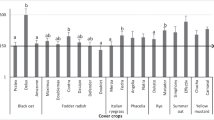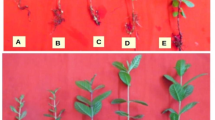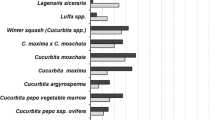Abstract
Pasteuria penetrans will build-up faster where there is a high initial nematode density and can suppress root-knot nematode populations in the roots of tomato plants. The effect of different densities of nematode (Meloidogyne javanica) (150, 750, 1500, 3000) and P. penetrans infected females (F1, F3) densities (F0=control and AC=absolute control without nematode or P. penetrans inoculum) on the build-up of Pasteuria population was investigated over four crop cycles. Two major points of interest were highlighted. First, that within a confined soil volume, densities of P. penetrans can increase >100 times within 2 or 3 crop cycles. Second, from a relatively small amount of spore inoculum, infection of the host is very high. There were more infected females in the higher P. penetrans doses. The root growth data confirms the greater number of females in the controls particularly at the higher inoculum densities in the third and fourth crops. P. penetrans generally caused the fresh root weights to be higher than those in the control. P. penetrans has shown greater reduction of egg masses per plant at most densities. The effects of different initial densities of M. javanica and P. penetrans on the development of the pest and parasite populations were monitored. And no attempt was made to return the P. penetrans spores to the pots after each crop so the build-up in actual numbers of infected females and spores under natural conditions may be underestimated.
Similar content being viewed by others
References
Davies, K.G., Kerry, B.R., Flynn, C.A., 1988. Observations on the pathognecity ofPasteuria penetrans, a parasite of root-knot nematodes,Annals of Applied Biology,112:491–501
Davies, K.G., Larid, V., Kerry, B.R., 1991. The motility, development and infection ofMeloidogyne incognita encumbered with spores of the obligate hyperparasitePasteuria penetrans.Revue de Nematologie,14:611–618.
Hussey, R.S., 1985. Host Parasite Relationships and Associated Physiological Changes.In: Sasser, J.N., Carter, C.C. (Eds.), An Advanced Treatise on Meloidogyne Vol. 1: Biology and Control. North Carolina State University, Graphics, p.143–153.
Mankau, R., Imbriani, J.L., 1975. The life cycle of an endoparasite in some Tylenchid nematodes.Nematologica,21:89–94.
Pinnock, D.E., Brand, R.N., 1981. A Quantitative Approach to the Ecology of the Use of Pathogens for Insect Control.In: Burges, H.D. (Ed.), Microbial Control of Pests and Plant Diseases, 1970–1980. Academic Press, London, p.654–665.
Serracin, M., Schuerger, A.C., Dickson, D.W., Weingartner, D.P., 1997. Temperature-dependant development ofPasteuria penetrans inMeloidogyne arenaria.Journal of Nematology,29:228–238.
Sayre, R.M., Wergin, W.P., 1977. Bacterial parasite of a plant nematode: morphology and ultra structure.Journal of Bacteriology,129:1091–1101.
Stirling, G.R., 1981. Effect of temperature on infection ofMeloidogyne javanica byBacillus penetrans.Nematologica,27:458–462.
Stirling, G.R., 1984. Biological control ofMeloidogyne javanica withBacillus penetrans.Phytopathology,74:55–60.
Stirling, G.R., 1991. Biological Control of Plant-Parasitic Nematodes. Progress, Problems and Prospects. CAB International, Wallingford.
Southey, J.F., 1986. Laboratory Methods for Work with Plant and Soil Nematodes. MAFF/ADAS, Her Majesty's Stationery Office, London, p.202.
Tzortzakakis, E.A., Gowen, S.R., 1994. Resistance of a population ofMeloidogyne spp. to parasitism by the obligate parasitePasteuria penetrans.Nematologica,40:258–266.
Tzortzakakis, E.A., Channer, A.G.D.R., Gowen, S.R., Ahmed, R., 1997. Studies on the potential use ofPasteuria penetrans as a biocontrol agent of root-knot nematodes (Meloidogyne spp.).Plant Pathology,46:44–55.
Whitehead, A.D., 1998. Plant Nematode Control. CAB International, Wallingford, p.384.
Author information
Authors and Affiliations
Corresponding author
Rights and permissions
About this article
Cite this article
Darban, D., Pathan, M., Bhatti, A. et al. The effect of different initial densities of nematode (Meloidogyne javanica) on the build-up of Pasteuria penetrans population. J Zheijang Univ Sci B 6, 113–118 (2005). https://doi.org/10.1631/jzus.2005.B0113
Received:
Accepted:
Published:
Issue Date:
DOI: https://doi.org/10.1631/jzus.2005.B0113




